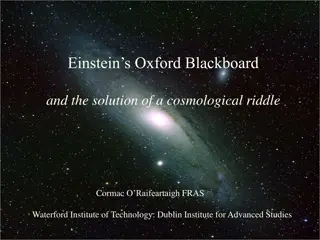Journey Through the Cosmos: From Einstein's Theories to the Big Bang
Explore the evolution of our understanding of the universe, from Einstein's initial beliefs in a static cosmos to the groundbreaking discoveries of an expanding universe and the Big Bang theory. Witness how observations of galaxies moving away in all directions and the cosmic microwave background radiation provide compelling evidence for the universe's origin and expansion. Delve into the complexities of space, time, and the critical density of the universe, shedding light on the cosmic puzzle that continues to captivate scientists and astronomers.
Download Presentation

Please find below an Image/Link to download the presentation.
The content on the website is provided AS IS for your information and personal use only. It may not be sold, licensed, or shared on other websites without obtaining consent from the author.If you encounter any issues during the download, it is possible that the publisher has removed the file from their server.
You are allowed to download the files provided on this website for personal or commercial use, subject to the condition that they are used lawfully. All files are the property of their respective owners.
The content on the website is provided AS IS for your information and personal use only. It may not be sold, licensed, or shared on other websites without obtaining consent from the author.
E N D
Presentation Transcript
If you look up at the sky at night, the heavens appear to be unchanging. In 1917 Einstein wrote down the theory of General Relativity. His equations indicated that the universe was expanding and decelerating. He believed that the universe was unchanging so he put in the cosmological constant to fix his equations.
In 1929 Edwin Hubble found that galaxies are flying away from us in every direction. The farther they are, the faster they are receding. This is evidence for the expansion of the universe.
The Big Bang Scientists now believe that the universe began in a tremendous release of energy known as the Big Bang. The universe has been expanding ever since. Evidence for this: Observation of galaxies flying away from us in all directions (Hubble s observations).
Expansion of the Universe The expansion of the universe can be viewed as stretching the spacetime fabric of the universe. Light waves get stretched out by expansion.
Chance of winning the Publishers Clearing House Sweepstakes: 1 in 10,000,000 (roughly) Chance of getting the initial density of the Universe correct (at 10-40 seconds after the Big Bang): 1 in 10000 0000 About 55 zeros The initial density of the universe must be veryclose to the critical density : Initial density Critical density = 1 + 0.000 0000001 _ About 55 zeros
Origin of the Universe Scientists believe that the universe began in a tremendous release of energy known as the Big Bang. The universe has been expanding ever since. Evidence for this: Observation of galaxies flying away from us in all directions. Remnant of the Big Bang known as the Cosmic Microwave Background Radiation.
In 1964 Penzias and Wilson discovered the remnant heat of the Big Bang. This is called the cosmic microwave background radiation. It is all around us. The universe has cooled off considerably. The radiation corresponds to a temperature of 3 degrees above absolute zero (- 454 F).
Origin of the Universe Scientists believe that the universe began in a tremendous release of energy known as the Big Bang. The universe has been expanding ever since. Evidence for this: Observation of galaxies flying away from us in all directions. Remnant of the Big Bang known as the Cosmic Microwave Background Radiation. Observed abundance of light elements made in the Big Bang matches predictions.
Star Formation Eventually the universe cooled and atoms formed. With the help of gravity these atoms (mostly hydrogen) clumped together to form stars.
ATOMS PROTON NEUTRON ELECTRON (+) (0) (-) HYDROGEN ATOM (H) Combine 4 hydrogen atoms to make a helium atom. This is called fusion. It powers the sun. 4 HELIUM ATOM (He)
NUCLEOSYNTHESIS: Making heavier atoms by combining lighter atoms. This occurs in stars and is called fusion. This is where stars get the energy to shine. 4 4 + 8 + He He Be (Beryllium) 8 + 4 12 Be + He C (Carbon) 12 16 4 + C O (Oxygen) + He Elements are made in stars. You are made of the stuff of stars.
Distance between Stars Fortunately for us, the average distance between stars is about 3 light years or 20 trillion miles. If stars were 10 times closer (~2 trillion miles), a nearby star could pull the earth into an eccentric orbit and kill life here. If the stars were much farther apart, then there would not be enough heavy elements to make life. Heavy elements (like carbon and oxygen) are the ashes of dead stars and living things need these elements.























